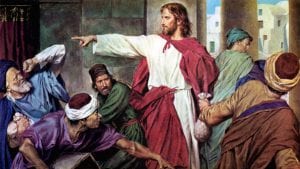
Cleansing the Temple
The cleansing of the Temple happened just around Passover – the feast of the Jews which was kept on the fourteenth day of Nisan, in commemoration of the Lord’s passing over the dwellings of the Israelites, as the Lord struck down every firstborn in the land of Egypt. (Exodus 12:29-30)
We can just imagine how busy the Temple area must have been; according to the Jewish historian Josephus: no fewer than two hundred and fifty-six thousand five hundred sacrifices were offered at one Passover.
There were two groups of people which Jesus drove out from the Temple are: the moneychangers, who changed foreign and domestic currency to the half-shekel, which was used by people to pay the Temple tax, and those who sold oxen, sheep and doves, and other things necessary for people to offer sacrifice.
Many commentaries argue that Jesus may have cleansed the Temple twice: the first time at the beginning of His public ministry based on the chronology in John’s Gospel, and a second time just before His Passion and Death, based on the chronology in Matthew, Mark and Luke.
Many commentaries also argue whether or not Jesus used violence in driving out the moneychangers from the temple. None of the four Gospels say that Jesus actually struck the people or the animals, but that He drove them out. Nonetheless, it was a chaotic scene: Jesus overturned tables, money spilling out, the traders trying to protect their property, animals rushing here and there. Indeed, the scene made an impact on the disciples as they remembered Psalm 69 and saw in their Master’s actions a zeal for His Father’s house.
What is the significance of the cleansing of the Temple?
- Once again, Jesus fulfilled the Law: On the eve of the Passover the head of every family carefully collected all the leaven in the house, and there was a general cleansing. When Jesus drove out the moneychangers and those who sold the animals, He was cleansing His Father’s house of the leaven of irreverence, thievery and dishonesty. Jesus also fulfilled the prophecies of the prophets: “Zeal for your house will consume me.” (Psalm 69:10) and “The Lord whom you seek will come suddenly to his temple; but who can endure the day of his coming? Who can stand firm when he appears?” (Malachi 3:1-2)
- With reference to the chronology of the Gospels of Matthew, Mark and Luke, the cleansing of the Temple paved the way for Jesus’ Passion, Death and Resurrection. The chief priests, scribes and leaders of the people sought a way to put Jesus to death.
- Jesus prophesied His Death and Resurrection. The Jews had asked a sign from Jesus to prove His authority. Jesus tells them, “Destroy this temple and in three days I will raise it up. (John 2:19)” Jesus was talking about the Temple of His Body, which He will raise up three days after His Death (cf. John 2:21). This statement parallels what Jesus said to the scribes and the Pharisees who asked for a sign; Jesus said, “An evil and unfaithful generation seeks a sign, but no sign will be given it except the sign of Jonah the prophet. Just as Jonah was in the belly of the whale three days and three nights, so will the Son of Man be in the heart of the earth three days and three nights.” (Matthew 12:39-40)